Zantedeschia
Zantedeschia Spreng.
Family: Araceae
Common names: arum lilies, calla lilies, pig lily (Eng.); varkblom (Afr.)
Introduction
Clump-forming perennials, cherished around the globe for their lush foliage and ornate blooms of white, yellow, pink and red.

Description
Description
Plants of the genus Zantedeschia are deciduous perennials (may be evergreen) up to 1 m high and survive the dry season through rhizomes or tubers. They have many leaves that are ovate or arrow-shaped and plain green or white-speckled.

The inflorescence consists of a spathe, a large modified leaf around a central axis called the spadix that carries minute flowers densely congested, female flowers at base and males above. Spathes are funnel-shaped or cylindrical, white, cream, yellow, pink or red, with or without a dark purple marking at the base inside, mostly persistent and green when fruit are ripe.
Flowers are unisexual and naked (without a perianth). Pollen is white and released in long, fine threads. The stigma is broad and produces a sticky shiny secretion, possibly as a sugar reward to insect visitors. Fruit are berries, clustered, each with few to many seeds, green or orange when ripe, surrounded by the partial or entire spathe. Seeds with mucus, round or oval, cream or brown.

Conservation Status
Status
Four species of Zantedeschia are threatened due to their restricted distribution range in South Africa. Of these, the yellow-spathed Z. jucunda and Z. pentlandii are under severe threat partly due to their attractive spathes. The other two species, Z. odorata and Z. valida, have white spathes and, though not threatened, are known from limited populations at single localities which have to be conserved. All these species are restricted to rocky outcrops. Z. jucunda is declining as a result of plants being removed for horticultural purposes. During peak flowering in November and December, plants are dug up and sold by the local people. The subpopulations of Z. pentlandii are fragmented and are declining due to mining and horticultural trade.
Distribution and habitat
Distribution description
Zantedeschia is a genus of eight species, seven species confined to southern Africa, and one species, Z. albomaculata, which extends into south-central Africa northwards to Tanzania. Z. elliotiana is known only from cultivation. The centre of diversity for the genus is Lydenburg in Mpumalanga where four species occur. Plants of Zantedeschia grow in the grassland, savanna and fynbos biomes, in full sun, less often in partial shade, and they occur in areas with seasonal rainfall. All species occur in the summer rainfall areas, except for Z. odorata at Nieuwoudtville (winter rainfall), and Z. aethiopica which is widespread and commonly found in marshy areas.
Derivation of name and historical aspects
History
The genus was named by Sprengel in honour of Professor Giovanni Zantedeschi (1773 –1846), a botanist of Brescia, Italy.
Ecology
Ecology
In most Zantedeschia species, tubers are buried in crevices of rocks. This presumably is an adaptation to keep the tubers and roots cool over the dry season, and in the rainy season the plants benefit from water channelled into the crevices. Being buried among rocks also protects the tubers from porcupines.
Beetles are the most likely pollinators of Zantedeschia flowers. Beetles belonging in the genera Anoplachilius MacLeay and Leucocelis Burrmeister (Family Scarabaeidae) use the spathes in Z. aethiopica for mating. The gravid female beetles possibly seek a place at the base of spathes, in the zone of female flowers, to lay their eggs, while the males enter spathes for mating. Pollen held in threads is carried on the bodies of beetles. A dark purple marking is constant in spathes of Z. jucunda , Z. pentlandii and Z. valida. It probably mimics the remains of dead flesh and aids in attracting carrion beetles that effect pollination. The purple marking is, however, absent in spathes of Z. aethiopica and Z. odorata. Scent is present in the inflorescences of these species which possibly attracts pollinators. Spiders trap flies as food in the spathes and may accidentally effect pollination.
Uses
Use
The tubers of Z. aethiopica and Z. albomaculata are reported to be eaten by some African communities in southern Africa. Eating raw tubers causes irritation of the mouth. In the early days the tubers of Z. aethiopica were boiled and fed to pigs, hence the vernacular name “pig lily". Although a good source of starch, tubers of Zantedeschia are not used as a food crop, as are Colocasia antiquorum var. esculenta (madumbe, taro) and Xanthosoma sagittifolium (cocoyams), possibly because of the stinging sensation caused by raphides (needle-like crystals) in the mouth.
The leaves of Z. aethiopica are cooked as a pot herb by the African and Indian communities in South Africa. The Africans boil the leaves before braising them in oil with onions and chillies. The cooked herb is eaten with maize meal porridge (pap). The herb adds flavour to the plainer porridge. The Indians braise the cut leaves with onions and chillies. They soak tamarind (Tamarindus indica L.) in water and add the juice to the herb. Both boiling and tamarind seem to effectively break down raphides of calcium oxalate in the leaves. If not properly cooked, the herb causes a burning sensation in the mouth and throat, due to the raphides which cause minute lesions. The presence of raphides may be of relevance to anti-herbivory.
Zantedeschia plays a limited role in traditional medicinal practices. Warmed leaves of Z. aethiopica are applied to sores, boils and insect bites by the Xhosa and Whites in South Africa. The same preparation is used to treat gout and rheumatism. A decoction of Z. albomaculata is used by Zulu women to prevent repeated miscarriages and giving birth to weak babies.
Growing Zantedeschia
Grow
Since introduced into cultivation in 1731, the attractive white arum lily, Z. aethiopica, has become well-known world-wide. It enjoyed being the only cultivated member of the genus until the middle of the nineteenth century, when species with colourful spathes entered the trade. Today, numerous Zantedeschia cultivars are available as garden and pot plants and, due to their decorative and long-lasting spathes, they are popular as cut-flowers. These cultivars generate high revenue in New Zealand, USA and the Netherlands.
Plants in the genus prefer full sun, soil rich in humus, and seasonal watering. Z. aethiopica grows in both the summer and winter rainfall areas and is evergreen, but will become dormant in dry conditions. All other species (except Z. odorata ) occur in the summer rainfall region, and are dormant in winter. They must therefore be kept dry in winter. Z. odorata, being a winter rainfall plant, is dormant in summer and must be kept dry in the summer months.
Plants in cultivation need to be lifted at the onset of dormancy and stored dry until the start of the growing season. Species with colourful spathes are frost sensitive and more susceptible to soft rot, caused by the Erwinia bacterium. Conditions for soft rot are favourable when temperatures and humidity are high, or nitrogen levels in the soil are high and aeration low. Zantedeschia plants propagate well from seed, and plants can be divided by splitting clump tubers at the start of spring. Caterpillars feed on the young leaves of Zantedeschia at the start of the growing season, making plants appear leafless.

The most common species has been described previously in this series. See Zantedeschia aethiopica (L.) Spreng.
Species
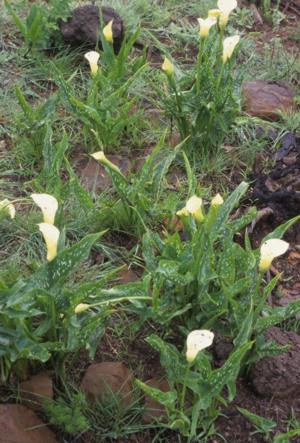
albomaculata (Hook.) Baill.
Common names: Arrow-leaved arum, spotted-leaved arum (Eng.); kleinvarkoor, witvlekvarkoor (Afr.); mohalalitoe (South Sotho); intebe (Xhosa, Zulu), ilabatheka-elimhlophe (Zulu), ilabatheka-omhlophe (Zulu). These are deciduous, medium to tall plants up to 0.7 m high, growing in small clumps. They have oblong or triangular arrow-shaped leaves, often speckled with white spots. Spathes are cylindrical, white, cream or pale yellow and frequently dark purple at the base within.
subsp. albomaculata
Leaves oblong, spathe tapering to apex, berries many, medium-sized, up to 18 mm in diameter. It flowers October to April. The subspecies occurs in the Eastern Cape, KwaZulu-Natal, Lesotho, Free State, Swaziland, Mpumalanga and Limpopo. It also extends into Zimbabwe, Malawi, Zambia, Angola and Tanzania. It is found along rocky hillsides, forest margins and stream banks.
subsp. macrocarpa (Engl.) Letty
Leaves triangular, spathe shortened at apex, berries few, large, mostly close to 20 mm in diameter. It flowers from November to April with a peak in December. The subspecies occurs in KwaZulu-Natal, Lesotho, Free State, Swaziland, Mpumalanga and Gauteng. It grows in grassy vleis and marshy ground beside streams.
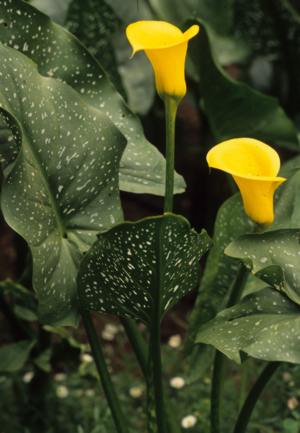
Zantedeschia elliotiana (Watson) Engl.
These are deciduous, medium to tall plants up to 0.6 m high, growing singly or forming small clumps. Their leaves are large, broadly ovate, deep green and speckled with white spots. The spathe is a cup-shaped funnel, bright golden-yellow and dark purple at the base within. It flowers November to January.
The species is known only from cultivated specimens and has not been found in the wild. It is probably a hybrid of garden origin. Suspected parents include Z. pentlandii or Z. jucunda and Z. albomaculata subsp. albomaculata.
Zantedeschia odorata P.L.Perry
These are deciduous, medium to tall plants up to 0.75 m high. Their leaves are broadly ovate and not speckled. Spathes are cylindrical and white. They flower in late July and August.
Z. odorata is restricted to an area known as Klip Koppies at Nieuwoudtville in the Northern Cape. The outcrops are formed by large dolerite boulders which break down to form a red clay soil which retains water well in the rainy season. The plants grow in crevices between the boulders, where at least the lower part of the plant is in cool shade. The roots are in seasonally very wet soil or sometimes in standing water.
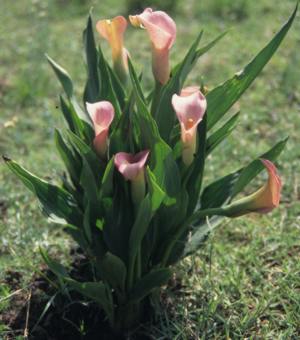
Zantedeschia rehmannii Engl.
These are small to medium plants 0.2–0.6 m high. Their leaves are lance-shaped, dark green and very rarely speckled with white spots. The spathes are cylindrical, colour ranging from white through shades of pink to dark maroon (almost black). They flower September to February, with a peak in November to January.
Z. rehmannii occurs from Harrismith in the Free State and northern KwaZulu-Natal, through Swaziland to Mpumalanga. This species grows among rocks on grassy hillsides at medium and quite high altitudes, in semi-shade at forest margins and in sandy furrows.
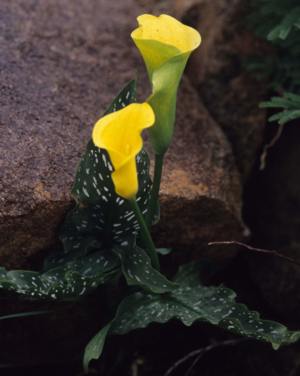
Zantedeschia jucunda Letty
Common name: magapule (Pedi)
These are deciduous, medium to tall plants, up to 0,8 m high, growing solitary or in small clumps. Their leaves are triangular-hastate, deep green and speckled with white spots. The spathe is a cup-shaped funnel, deep or cream-yellow and dark purple at the base within. They flower from November to January.
Z. jucunda is confined to the summit of the Leolo Mountains in the Sekhukuneland Centre of Floristic Endemism. This species grows on grassy slopes, among rocks in full sun.
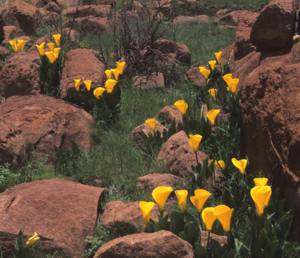
Zantedeschia pentlandii (Watson) Wittm.
Common name: Mapoch lily
These are deciduous, medium to tall plants, up to 0.6 m tall. Leaves broadly ovate, glaucous green and very rarely speckled with white spots. The spathe is a cup-shaped funnel, lemon-chrome yellow and dark purple at the base within. They flower from November to December.
The species is restricted to the Mapoch region of Mpumalanga, comprising the northern part of the Belfast District and adjoining parts of the Lydenburg District. Plants often grow in dense colonies wedged between rocks. Tubers are relatively superficial and plants can be dug out easily.
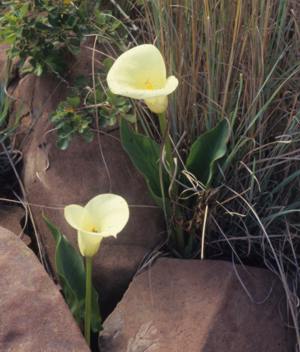
Zantedeschia valida (Letty) Y.Singh
These are deciduous, robust plants, up to 0.75 m tall. Leaves broadly ovate, plain, not speckled or very speckled with white spots. The spathe is a cup-shaped funnel dark purple at the base within. They flower from October to March with the peak in November.
The species is restricted to the region bordered by the Biggarsberg, Giants Castle and Collin's Pass in KwaZulu-Natal. Plants grow among rocks on the mountains in clefts and on foothills, as well as on the banks of streams and in vleis.
References
- Hutchings, A., Scott, A.H., Lewis, G. & Cunningham, A.B. 1996. Zulu medicinal plants: an inventory. University of Natal Press, Pietermaritzburg.
- Letty, C. 1973. The genus Zantedeschia. Bothalia 11: 5-26.
- Perry, P.L. 1989. A new species of Zantedeschia (Araceae) from the Western Cape. South African Journal of Botany 55(4): 447–451.
- Singh, Y., Van Wyk, A.E. & Baijnath, H. 1995. Know your arums: a comparative guide to the members of the genus Zantedeschia. Veld & Flora 81: 54-55.
- Singh, Y., Van Wyk, A.E. & Baijnath, H. 1996. Taxonomic notes on the genus Zantedeschia Spreng. (Araceae) in southern Africa. South African Journal of Botany 62: 321–324.
- Singh, Y. 1996. Contributions to the systematics of the genus Zantedeschia Spreng. (Araceae). MSc. thesis. University of Pretoria, Pretoria.
- Singh, Y., Craib, C. & Condy, G. 2007. Zantedeschia jucunda. Flowering Plants of Africa 60: 2-7.
- Snijder, R.C. 2004. Genetics of Erwinia resistance in Zantedeschia: impact of plastome-genome incompatibility. PhD thesis. Business Unit Biodiversity & Breeding, Wageningen, The Netherlands.
- Watt, J.M. & Breyer-Brandwijk, M.G. 1962. The medicinal and poisonous plants of southern and eastern Africa , edn 2. Livingstone, Edinburgh & London.
Credits
Yashica Singh
KwaZulu-Natal Herbarium
November 2012
Plant Attributes:
Plant Type: Bulb, Perennial
SA Distribution:
Soil type:
Flowering season:
PH:
Flower colour:
Aspect:
Gardening skill:
Special Features:
Horticultural zones






Rate this article
Article well written and informative
Rate this plant
Is this an interesting plant?
Login to add your Comment
Back to topNot registered yet? Click here to register.